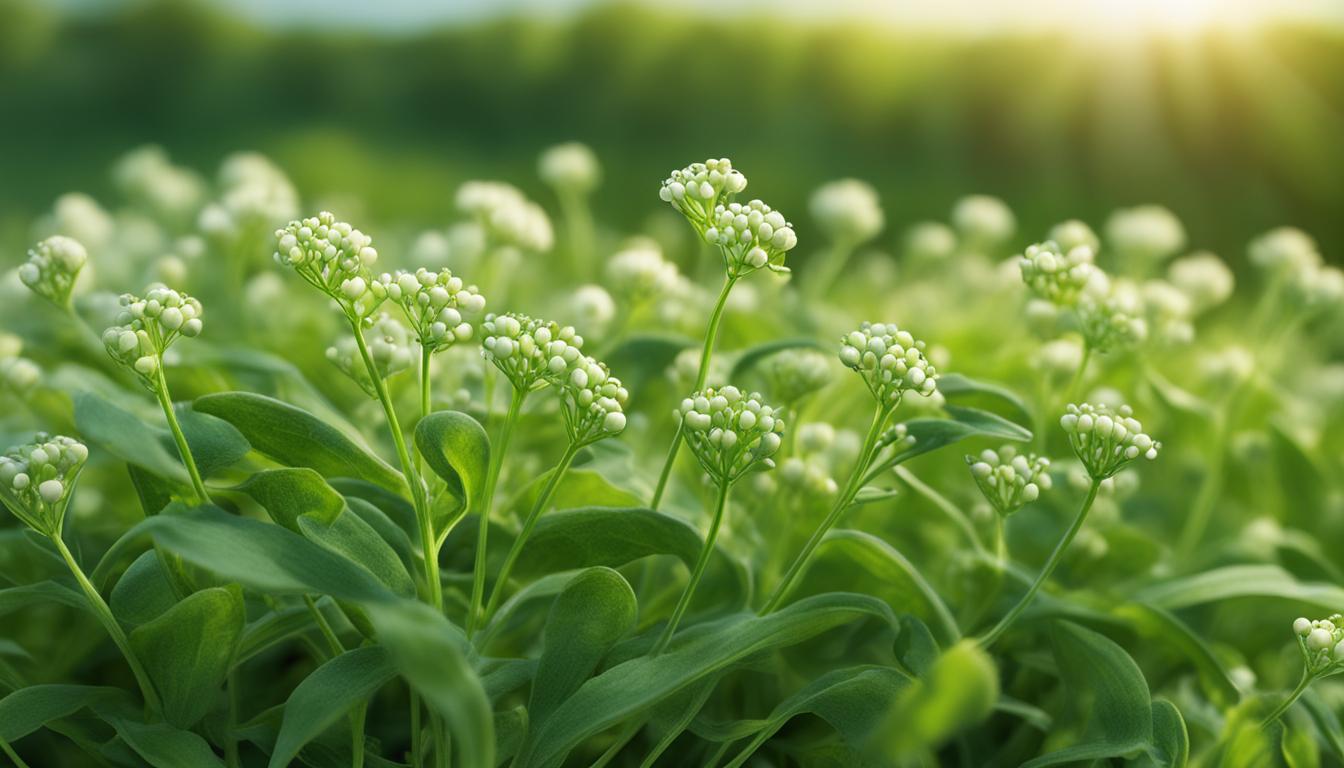Welcome to our article on Shepherd’s Purse, a versatile herb with a long history in traditional medicine and herbal remedies. Shepherd’s Purse, scientifically known as Capsella bursa-pastoris, is renowned for its potential therapeutic properties and numerous medicinal benefits. In this article, we will explore how Shepherd’s Purse has been used in traditional medicine, its natural healing properties, and the health benefits it offers as a herbal treatment. Let’s delve into the fascinating world of Shepherd’s Purse and discover the wonders of this age-old folk medicine.
Shepherd’s Purse has been valued throughout history for its diverse uses and healing properties. From wound healing to menstrual disorders, this herb has captivated herbalists and alternative medicine practitioners alike. Though scientific evidence is limited, Shepherd’s Purse continues to be enjoyed by many as a natural remedy.
In the following sections, we will explore specific uses of Shepherd’s Purse, such as its potential role in treating postpartum hemorrhage and managing menstrual bleeding. Additionally, we will discuss potential side effects, precautions, and how to make homemade Shepherd’s Purse tinctures and tea. We’ll also touch upon considerations for pregnancy and breastfeeding, and explore other herbal remedies that can complement Shepherd’s Purse.
It is important to note that while Shepherd’s Purse offers promising benefits, it’s essential to exercise caution and consult with a healthcare provider before incorporating it into your wellness routine. Let’s embark on this enlightening journey to uncover the therapeutic properties and potential of Shepherd’s Purse as a traditional herbal remedy.
Postpartum Hemorrhage: How Shepherd’s Purse Can Help
Postpartum hemorrhage, which refers to excessive bleeding after childbirth, can be a serious and potentially life-threatening complication. Shepherd’s purse, an herbal remedy, has shown promise in assisting with the treatment of postpartum hemorrhage. A study conducted on women with postpartum hemorrhage found that the combination of oxytocin, a hormone that helps reduce bleeding, and shepherd’s purse extract significantly decreased bleeding compared to the use of oxytocin alone.
While further research is needed to fully establish the effectiveness of shepherd’s purse in treating postpartum hemorrhage, these initial findings are promising. Shepherd’s purse extract may offer an alternative or complementary approach to traditional treatments for postpartum hemorrhage.

Managing Menstrual Bleeding with Shepherd’s Purse
Shepherd’s purse has long been recognized for its potential benefits in managing heavy menstrual bleeding. This natural remedy has been used traditionally to help regulate the menstrual cycle and reduce excessive bleeding. A recent study conducted on women with heavy menstrual bleeding revealed promising results when shepherd’s purse was combined with mefenamic acid, an anti-inflammatory drug commonly used to relieve menstrual pain.
In the study, the combination of mefenamic acid and shepherd’s purse significantly reduced the amount of menstrual bleeding compared to the use of mefenamic acid alone. This suggests that shepherd’s purse can play a role in managing heavy menstrual bleeding, providing relief for those who experience this common concern.
One popular way to consume shepherd’s purse is by preparing it as a nourishing tea. By brewing shepherd’s purse tea and incorporating it into your routine, you may be able to support the management of heavy menstrual bleeding. It is important to note that herbal remedies like shepherd’s purse should be used alongside other medications or supplements as recommended by your healthcare provider.

To help you understand the potential benefits of shepherd’s purse in managing heavy menstrual bleeding, here is a breakdown of the key findings from the study:
| Group | Medication/Supplement | Reduction in Menstrual Bleeding |
|---|---|---|
| Group A | Mefenamic Acid + Shepherd’s Purse | Significant reduction observed |
| Group B | Mefenamic Acid Only | Less reduction observed |
As shown above, the combination of mefenamic acid and shepherd’s purse demonstrated a substantial reduction in menstrual bleeding compared to the use of mefenamic acid alone. This highlights the potential of shepherd’s purse as an effective natural remedy for managing heavy menstrual bleeding.
It is worth mentioning that while shepherd’s purse may be beneficial for many individuals, it is always recommended to consult with a healthcare provider before incorporating herbal remedies into your routine. They can provide personalized guidance and ensure that shepherd’s purse is safe and appropriate for your specific health needs.
Please remember that this study is not conclusive evidence, and further research is needed to fully understand the effectiveness and safety of shepherd’s purse in managing heavy menstrual bleeding. Nevertheless, the results are encouraging, and shepherd’s purse remains a popular choice among individuals seeking natural alternatives for menstrual health.
Potential Side Effects and Precautions of Using Shepherd’s Purse
While shepherd’s purse is generally considered safe when taken in recommended amounts, it is important to be aware of potential side effects and take necessary precautions. Although human studies on shepherd’s purse are limited, animal studies have indicated some side effects, including drowsiness, shortness of breath, and pupil enlargement.
To ensure your safety and the optimal efficacy of shepherd’s purse, it is crucial to follow the recommended dosage provided on supplement packaging and consult with a healthcare provider before use. This is especially important if you are currently taking other medications or have specific medical conditions. Your healthcare provider can help determine the appropriate dosage and assess any potential interactions.
Please note that shepherd’s purse should not be used as a replacement for professional medical advice. Always consult with a healthcare provider before starting any new herbal supplement.
Potential Interactions
Shepherd’s purse may interact with certain medications and medical conditions. Here are a few important considerations:
- If you are taking blood thinners, shepherd’s purse may interfere with their effectiveness and increase the risk of serious health complications. It is important to inform your healthcare provider about your use of shepherd’s purse.
- Individuals with thyroid conditions should exercise caution when using shepherd’s purse, as it may interfere with thyroid medications and suppress thyroid function.
- Shepherd’s purse has sedative effects, and when combined with sedatives or sleep medications, it can increase drowsiness and impair coordination. It is essential to consult with your healthcare provider before using shepherd’s purse alongside any sedatives or sleep aids.
- If you have kidney disease or are on medications for kidney problems, it is advised to consult your healthcare provider before using shepherd’s purse, as it may potentially accumulate in the body.
Lastly, if you are scheduled for surgery, it is recommended to discontinue the use of shepherd’s purse at least two weeks prior to the procedure. This will help prevent any interference with anesthesia and blood clotting.
By being aware of these potential interactions and taking proper precautions, you can safely incorporate shepherd’s purse into your wellness routine.

How to Make Shepherd’s Purse Tincture and Tea
You can easily make your own shepherd’s purse tincture and tea at home using fresh or dried shepherd’s purse herb. Both the tincture and tea can be a convenient way to incorporate this herb into your daily routine for its potential health benefits.
Homemade Shepherd’s Purse Tincture
Making a shepherd’s purse tincture is a simple process that involves using alcohol, such as vodka, to extract the beneficial compounds from the herb. Here’s how you can make a homemade tincture:
- Fill a mason jar with fresh or dried shepherd’s purse herb.
- Completely cover the herb with vodka or another high-proof alcohol.
- Seal the jar tightly and store it in a cool, dark place for about 30 days.
- Remember to shake the jar occasionally during this time to help with the extraction.
- After 30 days, filter the liquid into a glass jar, discarding the plant material.
Your homemade shepherd’s purse tincture is now ready to use. Remember to label the jar with the date it was made and the dosage instructions.
Recommended Dosage for Homemade Tinctures
The recommended dosage for homemade shepherd’s purse tinctures is approximately 1 teaspoon (5 mL) per day. It’s best to start with a lower dosage and gradually increase it as needed. However, it’s essential to follow the recommended dosage provided on the tincture packaging or consult with a healthcare provider for personalized dosing instructions.
Making Shepherd’s Purse Tea
If you prefer a warm and soothing beverage, you can make shepherd’s purse tea using dried herb. Here’s a simple method:
- Bring a cup of water to a boil.
- Add 1-2 teaspoons of dried shepherd’s purse herb to a tea infuser or tea bag.
- Place the tea infuser or tea bag in a cup and pour the boiling water over it.
- Let the tea steep for 2-5 minutes, depending on your preference for strength.
- Remove the tea infuser or tea bag, and your shepherd’s purse tea is ready to enjoy.
You can customize your tea by adding sweetener or cream, if desired. It’s recommended to drink 1-2 cups of shepherd’s purse tea per day to potentially reap its benefits.

Shepherd’s Purse Storage and Handling Tips
Proper storage and handling of shepherd’s purse is essential to maintain its potency and effectiveness. Whether you have it in liquid, dried, or pill form, here are some tips to ensure the longevity of your shepherd’s purse:
- Storage: Store shepherd’s purse in a cool, dark place, such as a pantry or cupboard. This will protect it from light exposure which can degrade its quality.
- Liquid Extracts: If you have shepherd’s purse in liquid extract form, it is recommended to store it in blue or amber glass bottles. These colored bottles help shield the extract from light and preserve its potency for longer periods.
- Supplements: Many shepherd’s purse supplements have a shelf life of 1 year or more. However, it is advisable to check the expiration date mentioned on the packaging. It is recommended to discard them after the expiration date to ensure their freshness and effectiveness.
- Dried Shepherd’s Purse: Dried shepherd’s purse can theoretically last indefinitely if stored properly. Ensure that the dried herb is kept in an airtight container to prevent moisture absorption. If you notice any signs of moisture or visible mold, it is best to discard it immediately to avoid any potential risks.
By following these storage and handling tips, you can ensure that your shepherd’s purse remains fresh and effective for longer periods, allowing you to fully reap its potential benefits.

Considerations for Pregnancy and Breastfeeding
During pregnancy, it is essential to prioritize the safety of both the mother and the baby. While shepherd’s purse has potential uses in various health conditions, it is not recommended for use during pregnancy. This is due to its potential to affect the menstrual cycle and induce early labor, which can increase the risk of miscarriage. It is crucial to consult with a healthcare provider before considering any herbal remedies during pregnancy.
Similarly, there is limited evidence on the safety of shepherd’s purse during breastfeeding. As a precautionary measure, it is advisable to avoid the use of shepherd’s purse during this period to ensure the well-being of the nursing infant. Breastfeeding mothers should consult with a healthcare provider for guidance on suitable alternatives.
Shepherd’s purse may also have effects on blood circulation and thyroid function. Individuals who are taking blood thinning medication, have circulatory issues, or thyroid problems should exercise caution and avoid using shepherd’s purse. Consulting with a healthcare provider is recommended before initiating any herbal treatment.
Furthermore, children, adolescents, and individuals with kidney stones or kidney disease should also consult a healthcare provider before using shepherd’s purse. It is important to consider individual health factors and seek professional guidance to ensure safety and appropriateness of its use.

| Potential Considerations for Pregnancy and Breastfeeding |
|---|
| Shepherd’s purse is not recommended during pregnancy |
| Limited evidence on the safety during breastfeeding |
| Avoid use in individuals with circulatory issues |
| Avoid use in individuals with thyroid problems |
| Consult a healthcare provider before use in children, adolescents, and individuals with kidney stones or kidney disease |
Exploring Alternative Herbal Remedies
Looking to supplement your use of shepherd’s purse with other alternative remedies? Consider the therapeutic benefits of lady’s mantle and yarrow. These herbal remedies are frequently used in combination with shepherd’s purse to enhance their potential healing properties.
Lady’s Mantle
Believed to promote wound healing, lady’s mantle has been historically used to alleviate heavy menstrual bleeding. While further research is needed to substantiate these claims, many find it beneficial in managing abnormally heavy periods.
Yarrow
With its potential to aid in wound healing and normalize menstruation, yarrow is another alternative herbal remedy worth exploring. While scientific studies are underway to fully comprehend its effects, yarrow has been used traditionally to improve the health of the menstrual cycle.
You can incorporate lady’s mantle and yarrow into your routine by consuming them as teas or tinctures alongside shepherd’s purse. This combination may potentially enhance the therapeutic properties of all three remedies.
Now let’s take a look at a detailed table comparing the key characteristics of lady’s mantle, yarrow, and shepherd’s purse:
| Herb | Therapeutic Benefits | Usage | Preparations |
|---|---|---|---|
| Lady’s Mantle | Promotes wound healing May help reduce heavy menstrual bleeding |
Tea, tincture | Infuse dried herb in boiling water Steep in alcohol for a tincture |
| Yarrow | Assists in wound healing May aid in normalizing menstruation |
Tea, tincture | Infuse dried herb in boiling water Steep in alcohol for a tincture |
| Shepherd’s Purse | Promotes wound healing May reduce bleeding and normalize menstruation |
Tea, tincture, capsules | Infuse dried herb in boiling water Steep in alcohol for a tincture Take as recommended in capsule form |
Potential Interactions and Precautions
When using shepherd’s purse, it’s important to be aware of potential interactions with certain medications and medical conditions. Taking precautions and understanding the risks can help ensure your safety and well-being.
Interactions with Blood Thinners
Shepherd’s purse may interact with blood thinners, increasing the risk of serious health complications. The herb has the potential to interfere with the effectiveness of blood thinning medications, which are commonly prescribed to prevent blood clots. If you are taking blood thinners, it is advisable to avoid using shepherd’s purse without consulting your healthcare provider.
Interactions with Thyroid Medications
Individuals with thyroid conditions should exercise caution when using shepherd’s purse. The herb can interfere with thyroid medications and may suppress thyroid function. If you are taking thyroid medications or have a thyroid condition, it is best to avoid using shepherd’s purse without consulting your healthcare provider.
Sedative Effects
Shepherd’s purse can have sedative effects, which may be dangerous when combined with sedatives or sleep medications. If you are taking sedatives or sleep medications, it is important to avoid using shepherd’s purse without consulting your healthcare provider to prevent excessive drowsiness or sedation.
Kidney Disease
Individuals with kidney disease should consult their healthcare provider before using shepherd’s purse. The herb has the potential to accumulate in the kidneys, which may worsen kidney function in people with existing kidney disease. It is important to seek professional advice to determine whether shepherd’s purse is safe for you.
Surgery
If you have a surgery scheduled, it is advisable to discontinue using shepherd’s purse at least 2 weeks prior to the procedure. The herb may interfere with anesthesia and blood clotting, which can have implications for surgery and post-operative care. Inform your healthcare provider about your use of shepherd’s purse to ensure your safety during the surgical process.
By being mindful of these interactions and precautions, you can make informed decisions about using shepherd’s purse and prioritize your health and well-being.
Conclusion
Summarizing the benefits of shepherd’s purse, this versatile herb has been widely used in traditional medicine for its potential healing properties. Although scientific evidence is limited, many people rely on shepherd’s purse as a natural remedy. Its reputed benefits include wound healing, reducing bleeding, and managing menstrual disorders. However, it is crucial to exercise caution and consult with a healthcare provider before using shepherd’s purse, especially if you have specific medical conditions or are taking medications.
As with any herbal remedy, the safety and efficacy of shepherd’s purse require further research. While it has been used for centuries in traditional medicine, more scientific studies are needed to fully understand its therapeutic properties. When incorporating shepherd’s purse into your health regimen, it is important to be aware of potential interactions and side effects.
Overall, shepherd’s purse holds promise as a herbal remedy in traditional medicine. However, until more conclusive scientific evidence is available, it is advisable to approach its usage with caution and seek professional guidance from a healthcare provider. By doing so, you can make informed decisions about incorporating shepherd’s purse into your holistic well-being journey.
FAQ
What are the therapeutic properties of shepherd’s purse?
Shepherd’s purse is believed to have potential therapeutic properties, including wound healing, reducing bleeding, and aiding in menstrual disorders. However, more research is needed to fully understand these effects.
How can shepherd’s purse help with postpartum hemorrhage?
A combination of oxytocin and shepherd’s purse extract has been found to significantly decrease bleeding in women with postpartum hemorrhage. Further research is needed to establish its effectiveness.
Can shepherd’s purse help manage heavy menstrual bleeding?
Shepherd’s purse, when combined with mefenamic acid, has been found to reduce the amount of menstrual bleeding in women with heavy menstrual bleeding. It can be consumed as a tea along with other medications or supplements.
Are there any side effects or precautions associated with using shepherd’s purse?
While shepherd’s purse is generally considered safe when taken in recommended amounts, it may cause side effects such as drowsiness and shortness of breath. It is important to follow the recommended dosage and consult with a healthcare provider before use.
How can I make shepherd’s purse tincture and tea at home?
To make a tincture, fill a mason jar with shepherd’s purse herb and cover it completely with vodka. Let it sit for 30 days, shaking occasionally, and filter the liquid. To make a tea, steep dried shepherd’s purse herb in boiling water for 2-5 minutes. Drink 1-2 cups per day.
How should I store and handle shepherd’s purse?
Store shepherd’s purse in a cool, dark place like a pantry. Liquid extracts should be stored in blue or amber glass bottles to protect them from light exposure. Discard supplements after the expiration date. Dried shepherd’s purse can last indefinitely if there is no moisture or visible mold.
Can I use shepherd’s purse during pregnancy or breastfeeding?
Shepherd’s purse is not recommended for use during pregnancy or breastfeeding, as it may affect the menstrual cycle and induce early labor. Limited evidence is available on its safety during breastfeeding.
Are there alternative herbal remedies that work well with shepherd’s purse?
Lady’s mantle and yarrow are two alternative herbal remedies often used in combination with shepherd’s purse. Both are believed to have wound healing properties and may help in managing heavy menstrual bleeding, although more research is needed.
Are there any precautions or potential interactions with medications when using shepherd’s purse?
Shepherd’s purse may interact with blood thinners, thyroid medications, sedatives, and anesthesia. It may also accumulate in individuals with kidney disease. It is advisable to consult with a healthcare provider before using shepherd’s purse.
What are the key takeaways about shepherd’s purse and its uses?
Shepherd’s purse is a versatile herb with potential benefits in wound healing, reducing bleeding, and managing menstrual disorders. While scientific evidence is limited, many people use it as a natural remedy. However, caution should be exercised, and it is important to consult with a healthcare provider before use.
Source Links
- https://www.healthline.com/health/shepherds-purse
- https://www.webmd.com/vitamins/ai/ingredientmono-51/shepherds-purse
- https://www.rxlist.com/supplements/shepherds_purse.htm

